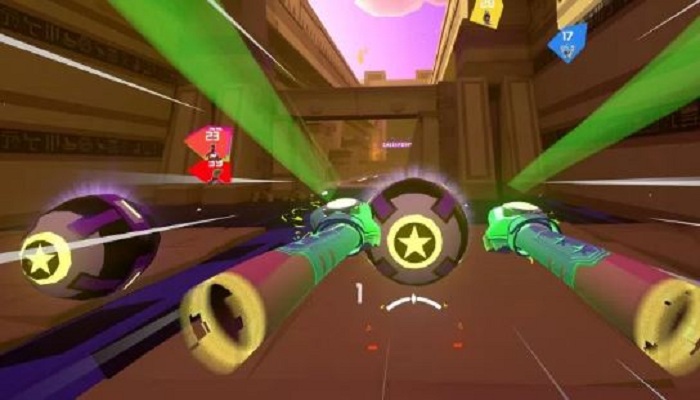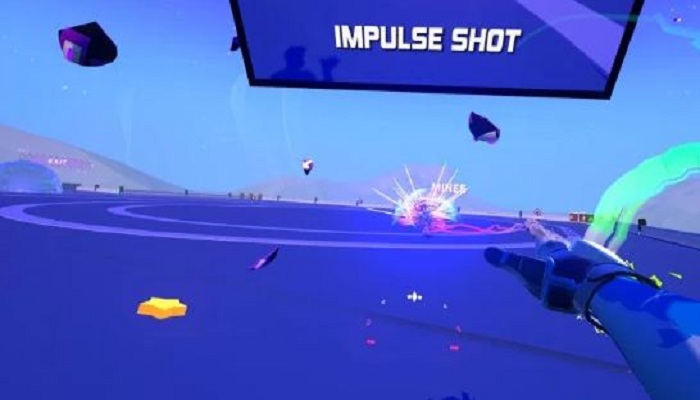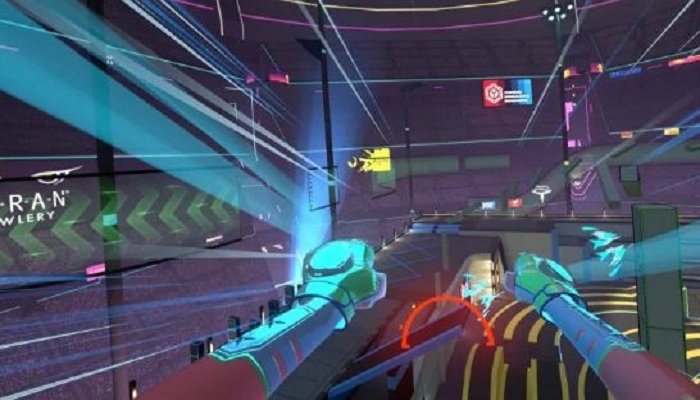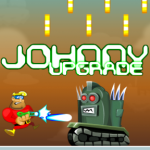Review: Sprint Vector – Earlier last year, PlayStation VR owners could forgo their couches/chairs, grab their MOVE controllers, and every night demonstrate their physical prowess with the Geeks Under Grace reviewed SPARC. It was unlike anything I had seen before, and a legitimate VR sport that actually led me to having sore muscles due to unintentional exercise. While my daily SPARC obsession has subsided, it left a hole in my video game active life. Thankfully, Sprint Vector, from developer Survios, has come at just the right moment, and it’s great to say that PS VR has been blessed with an all new solid VR sport title.
> Play now: actions games 3d very fun
Review: Sprint Vector
Content Guide
Violence: While racing, the player can shoot electric like bolts out of their hands to remove any breakable objects or knock other racers off balance. None of the violence is graphic in nature as there is no blood or gore.
Language/crude humor: I heard no swear words in my time playing. Since you are competing against other opponents, sometimes they will have playful banter before, during, and after the race. Mainly about how badly they’re going to beat you or remarking on how they will make you look slow.

Review: Sprint Vector
- In addition, Color Batteries is one of the fun games, getting a lot of affection for players around the world. Just click the “Play Now” button to enjoy the game, you will surely have a great time with an enjoyable experience. Join this game, your task is to shoot the colored balls on the spinning wheel. Prepare for a color combination, alternate changes and other changes gradually appear in the game. Click the “play now” button to play and feel!

Review
The thing you’ll be doing more than anything else in Sprint Vector is swinging your arms vigorously to gain momentum. It’s not enough to say this is just a workout, as oftentimes I felt like I had just ran an actual race. After six hours of playtime over multiple days, I found my upper body to be completely sore and that’s not an overstatement. You’ll have to master the “Fluid Locomotion” system which requires players to pump their arms as they stand in place in order to finish anywhere near the top three.
Before you begin a race there are eight characters to choose from, and each of the characters is colorful, quirky, and cartoonish. This is the only thing that makes them distinct though, as each of the contestants is equally balanced. This can be good and bad—good in a sense that no character is stronger than the other, but bad in the sense that it really doesn’t matter who you pick as there are no strengths and weaknesses.
While I did enjoy my time with the game’s multiplayer, there is no denying that matchmaking in the game is unbalanced and there is no type of leveling or matchmaking system. In one race you could be the fastest racer in the party, while in the next race the person who won is almost two minutes faster than you. This provides an excellent dosage of difficulty, but can also discourage those from playing online.
The visuals are a call back to titles like Jet Set Radio Future, and even the recently released PS VR title Starblood Arena with bright and colorful cel shaded graphics and plenty of style. Survios deciding to use cel shaded graphics was a smart move as the resolution won’t be any cause for alarm. The music, sound effects, and the race commentary are also done exceptionally well with adjustable volume sliders for all the sound components.
See more: Top action games for pc
As great as the gameplay actually felt, some other gameplay abnormalities would hinder my enjoyment. There were on a few occasions where I got stuck in geometry and had to restart the race due to there being no way to escape or reset yourself on the track. Sometimes I would end up moving backwards after being brought to a halt by an obstacle, despite performing the correct motions and this happened more often than I would care for. Thankfully, though, these annoyances didn’t hamper my overall enjoyment of Sprint Vector.
Overall, Sprint Vector features twelve tracks, eight racers, and nine single-player specific challenge maps, providing a solid amount of content that doesn’t overstay it’s welcome. I can see Sprint Vector being the type of game I keep coming back to just for racing online with friends, even if there is concern of it having any legs past the launch window. It’s safe to say though, Sprint Vector is some of the most fun I’ve had in a VR title. Unfortunately, it can also be very exhausting and there needs to be plenty of space to move your arms in comfortable motions.
Once you’ve got your head around the basic concept of movement, things start getting infinitely more tricky. Sprint Vector has an incredibly steep learning curve and there’s a lot to take in as you careen round the tracks; from chaining together double jumps and flying in order to cross large chasms, through to activating the many collectable power-ups. Learning how to drift turn correctly is one of the many advanced maneuvers you’ll need to master. By holding down the brake button on the side you want to turn to and pumping with the other arm your character will take tight bends without the need for you to physically turn your body in real life.
The game comes with around 12 tracks for competitive racing, although most maps do tend to reuse or reverse sections from existing levels. The first track, Winter Rush, is relatively gentle but as you progress through the game, the layouts become much more complex. Later races introduce a lot of verticality that will stop you dead in your tracks unless you’ve mastered how to climb walls correctly. By jumping at a wall and pulling the trigger on your controller at the right time you’ll grab onto a green handhold. Then by raising your hand above your head and pulling it down rapidly while releasing the trigger you’ll catapult yourself upwards. I found that movement in particular to be quite awkward to pull off correctly, the game would often fire me backwards away from the wall necessitating a frustrating reclimb. During the times when it did work, throwing myself up tall walls at speed was a great sensation; I felt like a super-powered Agent scaling skyscrapers in Crackdown.

Sprint Vector
Keeping a forward momentum is imperative if you want to win medals in Sprint Vector and there are plenty of boosts pads and nitro power-ups dotted around to help you do this. Conversely, there are so many hazards littering the tracks that crashing into objects and coming to an abrupt, jarring halt is only a matter of time. This is especially true in the early hours of the game when you are still feeling your way around each track.
Surprisingly, with all this extreme movement going on, Sprint Vector really nails the comfort factor when it comes to reducing nausea in VR. Falling down a big hole or launching yourself into a particularly powerful jump are things that will occasionally turn your stomach, but it’s never that extreme. By using actual, physical movements to control your character, it grounds you in the world and it means you’re less likely to experience that out-of-body jolt that can cause tummies to turn.
During solo play your fellow competitors, a colourful bunch of aliens, humanoids and holograms, will be controlled by AI. Whilst these opponents offer a slight challenge to anyone familiar with the tracks, if you continually fail a section of a race they will often stop and wait for you to catch up. That’s ever so nice of them, but it looks and feels a bit odd, especially when they decide to race back along the track to see how you’re doing.
There are multiple racers to choose from but they all control the same. The only noticable difference is the dialogue but that repeats itself so often you’ll want to turn it off eventually.
For an actual test of your skill you’ll need to go for online multiplayer and race real life people. I had a few problems finding opponents in the EU server but on the US side there were plenty of people to race with. Most of them had live mics but instead of being toxic, anyone who spoke was friendly and happy to offer help to newcomers, giving the lobbies a welcoming atmosphere.

Play now Sprint Vector
If you fancy taking some time out from all that competitive racing, there are a number of exclusive challenge maps on offer that’ll test your speed and ability to navigate the environment. Whether it be a time trial or an item collection run, nailing those top speeds and perfecting those routes can be quite addictive. In my mind these challenges felt very much like playing a VR version of Mirror’s Edge.
While most of my races, competitive or otherwise, went off without a hitch, I did have the occasional calibration issue. These could have been down to my tiny play area, or my own unwieldy movements but either way, every so often I’d boost wildly and unexpectedly to the left or right when trying to run forwards. More often than not this would put me at the bottom of a pit, forcing an aggravating restart at the nearest checkpoint.
With all this in mind my recommendation comes with a few caveats. If you’re a VR enthusiast with a decent sized games room and a good stomach for intense action then you’re in for a treat. If however you’re a VR beginner, or someone with a cramped gaming area, you do run the risk of feeling like you’ve wasted your money.
Don’t expect to just pick up this game and ace it straight away either. Getting to a point where you’re actually good enough to sprint around a course without crashing every 30 seconds or so will take a lot of practice and perseverance. The learning curve really is punishing and it’s imperative that you play through the four lengthy tutorials if you want to stand any chance of winning a race. Once that unique method of locomotion finally clicks though, the amazing feeling of physically powering your way through each level just cannot be matched by any VR game on the market.





